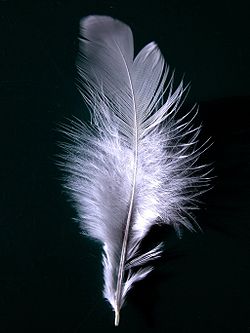White feather

The white feather is a widely recognised propaganda symbol.[1][2] The white feather was most prominently used in the 'white feather movement' in Britain during the First World War, in which women gave white feathers to non-enlisting men symbolizing cowardice and shaming them into signing up. The white feather movement is noted for that role of many prominent early feminists and suffragettes, such as Emmeline Pankhurst, and Emma Orczy in it.
Other than the White Feather movement, it has, among other things, represented cowardice or conscientious pacifism; as in A. E. W. Mason's 1902 book The Four Feathers. In the United States armed forces, however, it is used to signify extraordinary bravery and excellence in combat marksmanship.
History
[edit]As a symbol of cowardice
[edit]The use of the phrase "white feather" to symbolise cowardice is attested from the late 18th century, according to the Oxford English Dictionary. The OED cites A Classical Dictionary of the Vulgar Tongue (1785), in which lexicographer Francis Grose wrote "White feather, he has a white feather, he is a coward, an allusion to a game cock, where having a white feather, is a proof he is not of the true game breed".[3] This was in the context of cockfighting, a common entertainment in Georgian England.
The Crusades
[edit]Shame was exerted upon men in England and France who had not taken the cross at the time of the Third Crusade. "A great many men sent each other wool and distaff, hinting that if anyone failed to join this military undertaking they were only fit for women's work".[4] Wool played an important role in the medieval economy, and a distaff is a tool for spinning the raw material into yarn; the activities of textile production were so firmly associated with girls and women that "distaff" became a metonym for women's work.
World War I
[edit]
World War II
[edit]The white feather campaign was renewed during World War II.[5][6]
As a symbol of pacifism and peace
[edit]In contrast, the white feather has been used by some pacifist organisations as an icon of abstinence from violence.
In the 1870s, the Māori prophet of passive resistance Te Whiti o Rongomai promoted the wearing of white feathers by his followers at Parihaka. They are still worn by the iwi associated with that area, and by Te Āti Awa in Wellington. They are known as te raukura, which literally means the red feather, but metaphorically, the chiefly feather. They are usually three in number, interpreted as standing for "glory to God, peace on earth, goodwill toward people" (Luke 2:14). Albatross feathers are preferred but any white feathers will do. They are usually worn in the hair or on the lapel (but not from the ear).
Some time after the war, pacifists found an alternative interpretation of the white feather as a symbol of peace. The apocryphal story goes that in 1775, Quakers in a Friends meeting house in Easton, New York were faced by a tribe of Indians on the war path. Rather than flee, the Quakers fell silent and waited. The Indian chief came into the meeting house and finding no weapons he declared the Quakers as friends. On leaving he took a white feather from his quiver and attached it to the door as a sign to leave the building unharmed.
In 1937 the Peace Pledge Union sold 500 white feather badges as symbols of peace.
In popular culture
[edit]Other meanings
[edit]In the United States, the white feather has also become a symbol of courage, persistence, and superior combat marksmanship. Its most notable wearer was US Marine Corps Gunnery Sergeant Carlos Hathcock, who was awarded the Silver Star medal for bravery during the Vietnam War. Hathcock picked up a white feather on a mission and wore it in his hat to taunt the enemy. He was so feared by enemy troops that they put a price on his head. Its wear on combat headgear flaunts an insultingly-easy target for enemy snipers.[7]
See also
[edit]- Hazing – Rituals of humiliation used to initiate someone into a group
- White Feather Campaign
Notes
[edit]- ^ "White Feather". Etymonline.com. Retrieved 6 June 2012.
- ^ Kingsbury, Celia Malone (2010). For Home and Country: World War I Propaganda on the Home Front. University of Nebraska Press. p. 80.
- ^ Oxford English Dictionary. Oxford University Press. Retrieved 15 January 2022.
- ^ Hurlock, Kathryn (2012). Britain, Ireland and the Crusades, C.1000–1300. Macmillan International Higher Education. p. 88.
- ^ Goldstein, Joshua S. "The Women of World War I". Retrieved 28 November 2011.
- ^ "Can It Be True?" editorial by "W.M." from the 3 April 1940, issue of the Daily Mirror: "Is it possible that nitwit girls are reviving the infamous "white feather" campaign of the last war? Rumours reach us from Doncaster to the effect that certain female louts are thus insulting male workers in or out of reserved occupations". Referenced 29 October 2012, retrieved 29 January 2013
- ^ Charles Henderson. Marine Sniper. New York: Berkley Books, 1986. ISBN 0-425-18165-0.
